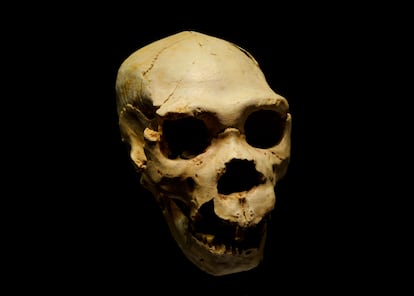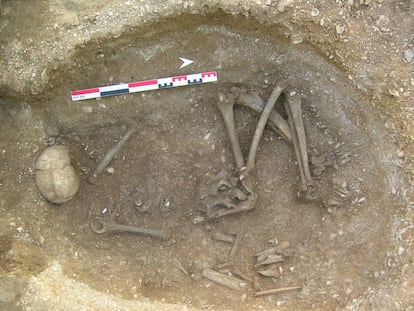Only 1,200 people left: The moment humanity almost went extinct
Genetic analysis suggests that the population of human ancestors was on the brink of extinction 930,000 years ago. That may have led to the emergence of a new species

930,000 years ago, the human race was on the verge of disappearing. Our ancestors had begun to spread across the planet. They walked upright and used simple stone tools. A few millennia earlier they numbered around 100,000, not many compared to the present, but enough to keep going in a hostile world. But something happened, and the population collapsed to 1,200 individuals. Some 98% of the entire population disappeared. Then, for 117,000 years — 1,170 centuries — that small population, which could fit in a nightclub, staved off extinction. Then, 800,000 years ago, the population recovered, little by little, to about 30,000 individuals.
This story takes place during the Paleolithic period, a time of change, when some animals replaced others in waves that swept the world from east to west, and climatic changes caused problems for our ancestors to the point that they were almost wiped out. That demographic bottleneck increased the evolutionary pressure on the few remaining humans and led to changes such as the fusion of two chromosomes into one that is very similar to our genome. It also triggered the emergence of a new species, perhaps the common ancestor between the now-extinct Neanderthals and Denisovans and Homo Sapiens. The latter human species outlived all the others, perhaps contributing to their extinction. Today’s 8 billion humans came from those 1,200 survivors.
According to an article published today in Science, that is essentially what happened in that long-ago time. In this study, in which researchers from China, Italy and the U.S. collaborated, the authors seek to illuminate the murky stage at the end of the Lower Pleistocene, when humanity’s penultimate great cognitive leap took place. For reasons that are still unknown, almost no fossils have been located from that era just over 900,000 years ago, with rare exceptions such as the pieces of skull discovered at Gombore in Ethiopia, and the remains of Homo antecessor in Atapuerca, Spain.
A common ancestor
In the absence of bones, the scientists worked with a technique called FitCoal, which makes it possible to infer what happened to the population from which an individual descended by studying its genome. The researchers used the genome sequences of 3,154 people from all over the world. In their analysis, they discovered a striking bottleneck that left our ancestors’ global population with just 1,280 individuals who could reproduce. With so few alternatives, inbreeding proliferated, and the effects of that loss of diversity can still be seen today. However, as the authors suggest, that moment of tribulation could have given rise to a new species, perhaps Homo heidelbergensis, the common ancestor of Neanderthals, Denisovans and Homo Sapiens.
As is almost always the case when one tries to travel so far back in time, speculation is necessary to cover part of the immense panorama, in which one speaks of millions of years as if a millennium were not an eternity. To explain the extensive loss of life, the authors of the Science article point to major climatic changes that prolonged glaciations and caused significant droughts in vast regions of the planet. To explain the recovery, which started some 813,000 years ago when the population increased 20-fold, they point to control of fire, evidence of which has already been found in Israel from 790,000 years ago, and a less hostile climate with more game and vegetables to satisfy hunger.
Antonio Rosas, the director of the Paleoanthropology Group at Spain’s National Museum of Natural Sciences in Madrid, acknowledges that the narrative that emerges from the study published today seems “nice,” but he also believes that it is “an ad hoc fit between the data they obtained and other paleontological data. Just as the lack of fossils could be explained by that bottleneck, [it could also be that] fewer fossils have been found because of volcanism or sedimentation,” he says. In addition, Rosas believes that the maintenance of such a small population for so many thousands of years “is not very credible,” because “it is beyond the usual population dynamics. Over such a long time, the circumstances would have changed to be able to recover,” he notes. “But in general, it is true that the bottleneck coincides with a phenomenon from the transition from the Lower to the Middle Pleistocene, which is a phenomenon of faunal replacement at the planetary level, especially in Eurasia. It is not a precise phenomenon, and that is where this phenomenon they observe occurs,” he concludes.
In addition to demonstrating a new technique for obtaining information from the deep past, the results published in Science provide another piece of information with which to continue reconstructing the evolutionary history of humankind. The hypotheses derived from the existence of this prolonged bottleneck will require the discovery of new fossils to complete the picture. While it is currently impossible, there is always the hope of recovering DNA from such ancient remains.
Antonio Salas, a specialist in population genetics at the University of Santiago de Compostela (Spain), highlights this work’s importance, but also notes the limitations of its approaches. “One could speculate that during the bottleneck period, speciation phenomena could have occurred that gave rise to the [last common ancestor] shared with the Denisovans, Neanderthals, with whom we diverged 765-550,000 years ago, but many of these phenomena have been irreversibly lost,” he observes. “Many methods that detect positive natural selection are based on the carryover that exists between the selected genetic variant and those that are in a dependent relationship with it… The signs of dependency between genetic variants can be lost in 10,000 years,” he adds. In the many vicissitudes that humanity has experienced over hundreds of thousands of years of evolution, many chapters of our history have been lost forever.
The study’s findings offer explanations, but questions remain. Salas wonders “where that ancestral population lived,” whether “they were small groups of interconnected hunter-gatherers” or had another way of life, and “what really happened to end up in that bottleneck.” He also asks, “how much of what happened to human lineage has been lost forever, in large part because of these demographic events?” The article’s authors believe that the bottleneck also may have increased our ancestors’ level of inbreeding, thereby contributing to the loss of 65% of human genetic diversity. Later, other stellar moments of humanity, such as the final departure from Africa 70,000 years ago, caused new bottlenecks and another reduction in diversity, which ended up forming a species in which we are all close relatives, the descendants of a handful of couples who miraculously survived.
Sign up for our weekly newsletter to get more English-language news coverage from EL PAÍS USA Edition
Tu suscripción se está usando en otro dispositivo
¿Quieres añadir otro usuario a tu suscripción?
Si continúas leyendo en este dispositivo, no se podrá leer en el otro.
FlechaTu suscripción se está usando en otro dispositivo y solo puedes acceder a EL PAÍS desde un dispositivo a la vez.
Si quieres compartir tu cuenta, cambia tu suscripción a la modalidad Premium, así podrás añadir otro usuario. Cada uno accederá con su propia cuenta de email, lo que os permitirá personalizar vuestra experiencia en EL PAÍS.
¿Tienes una suscripción de empresa? Accede aquí para contratar más cuentas.
En el caso de no saber quién está usando tu cuenta, te recomendamos cambiar tu contraseña aquí.
Si decides continuar compartiendo tu cuenta, este mensaje se mostrará en tu dispositivo y en el de la otra persona que está usando tu cuenta de forma indefinida, afectando a tu experiencia de lectura. Puedes consultar aquí los términos y condiciones de la suscripción digital.










































